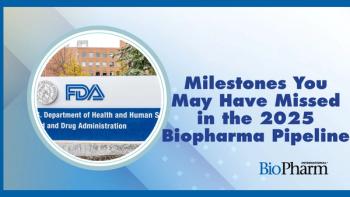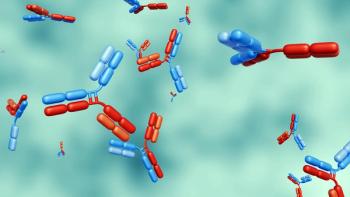
Nanoform’s New Partnerships Advance Localized Therapy and High-Concentration Biologics Delivery
Key Takeaways
- Nanoform's collaboration with Revio Therapeutics focuses on GLIORA, a hydrogel for glioma, enhancing localized drug delivery and reducing systemic toxicity.
- Proof-of-concept studies show nanoformulation's potential in high-concentration biologics, addressing viscosity and stability challenges in drug delivery.
The company demonstrates advances in glioma hydrogel, high-concentration biologics, and nanoencorafenib licensing, impacting drug delivery strategies.
Under three announced developments, Nanoform has demonstrated the application of its nanoformulation platform across oncology and
The latest of these announcements is a collaboration with Revio Therapeutics (Revio) to co-develop and commercialize GLIORA, a long-acting, locally delivered thermo-responsive hydrogel combining olaparib and temozolomide for high-grade glioma, an aggressive brain tumor (1,4). The hydrogel is designed for direct application to the tumor resection cavity during surgery, potentially increasing localized drug exposure while reducing systemic toxicity, according to an Oct. 27, 2025 company press release (1).
How does this hydrogel technology enable controlled release in glioma therapy?
The inclusion of olaparib, a poly (ADP-ribose) polymerase inhibitor, aims to exacerbate DNA damage in tumor cells and inhibit repair mechanisms, while Nanoform’s controlled expansion of supercritical solutions technology will be used to
“Developing a product like GLIORA for local, long-acting and safe delivery into a small dosing volume to fit into the tumor void space requires exquisite control over several parameters such as particle size, morphology, drug loading, release characteristics, and dose-ratio control,” said Prof. Edward Hæggström, CEO, Nanoform, in the October 27 press release (1).
This
How do high-concentration biologics studies advance drug delivery technologies?
Earlier in October, Nanoform announced results from two collaborative proof-of-concept studies, which were revealed at the 2025 Partnership Opportunities in Drug Delivery Summit in Boston, held Oct. 27–28. The studies explored the nanoformulation of a highly concentrated protein suspension—one for subcutaneous injection and one for a dry-powder inhaled alpha-1 antitrypsin (A1AT) formulation— using a novel solidification method (2).
High-concentration subcutaneous data from the one study demonstrated the ability to achieve target protein doses while maintaining acceptable syringeability, which addresses viscosity and stability challenges common in dense
What industry trends are reflected in Nanoform’s out-licensing deal?
In mid-October, Nanoform announced the formation of BRAFMed Ltd, in partnership with A.forall and IMGA, to develop and commercialize nanoencorafenib, a nanoengineered version of encorafenib, B-Raf proto-oncogene, serine/threonine kinase inhibitor (3). The nanoformulation increases drug load per dosage unit, potentially allowing fewer capsules and improved patient adherence compared to the marketed formulation, according to Nanoform in an Oct. 14, 2025 press release (3).
Nanoform granted BRAFMed an exclusive license to its intellectual property, and in return receives service fees, development milestones, and tiered royalties. “This announcement underscores investors’ and industry players’ confidence in our technologies, and we are pleased to welcome these highly experienced partners to drive this improved product forward,” Hæggström said in the October 14 press release (3).
This deal illustrates the broader industry trend of reformulating existing drugs to optimize dosing, improve patient adherence, and enable lifecycle management while sharing development risk with specialized partners (7).
Collectively, these developments indicate that nanoformulation technologies are increasingly applied to address clinical and biopharmaceutical challenges, from localized oncology delivery to biologics administration and reformulation of existing therapeutics (1,5,6). For industry stakeholders, such advancements suggest potential efficiency gains, new delivery modalities, and expanded treatment options that could influence pipeline strategies and formulation approaches (8).
What else is new at Nanoform?
On Nov 11, 2025, Nanoform announced that the Finnish Medicines Agency had granted the company a Commercial cGMP Manufacturing license "for the production and quality control of nanoformed small molecule APIs" (9). The new license authorizes Nanoform to manufacture nanoformed APIs for the European market, as well as for regions in the Middle East and North Africa, Asia, and the Americas that recognize the European authorization.
The company also received a cGMP Clinical License for its second GMP manufacturing suite, enabling the production of nanoformed APIs for use in clinical trials (9).
“We are delighted to have received these important licenses," said Johanna Kause, chief quality officer at Nanoform. "They represent a major step forward in bringing our proprietary particle engineering technology to the pharmaceutical industry.” Adding to these sentiments, Nanoform CEO Edward Hæggström said,
“Securing this commercial manufacturing license is a significant milestone for Nanoform. It enables us to begin market launches of our NanoImproved medicines, with Nanoenzalutamide targeted for its first European launch in 2028. We remain committed to delivering nanoformed medicines to patients” (9).
References
1. Nanoform Finland.
2. Nanoform Finland.
3. Nanoform Finland.
4. Collection of authors. High Grade Gliomas. Neuro Oncol. 2012, 14 (Suppl 1), i56–i68. DOI:
5. Ahmad, F.; Varghese, R.; Panda, S.; et al. Smart Nanoformulations for Brain Cancer Theranostics: Challenges and Promises. Cancers (Basel). 2022, 14 (21), 5389. DOI:
6. Nanoform Finland.
7. Research and Markets.
8. Research and Markets.
9. Nanoform.
Newsletter
Stay at the forefront of biopharmaceutical innovation—subscribe to BioPharm International for expert insights on drug development, manufacturing, compliance, and more.





